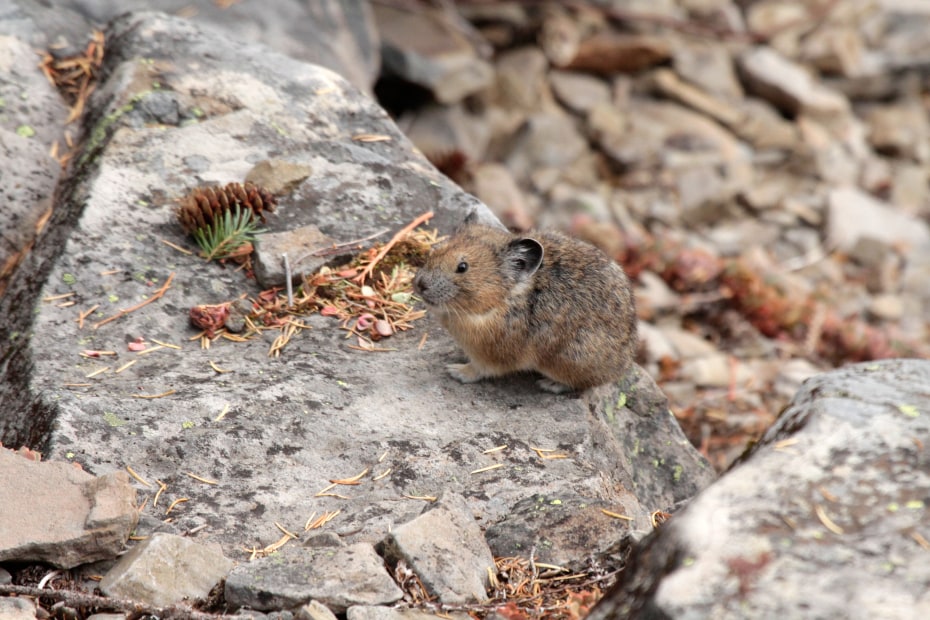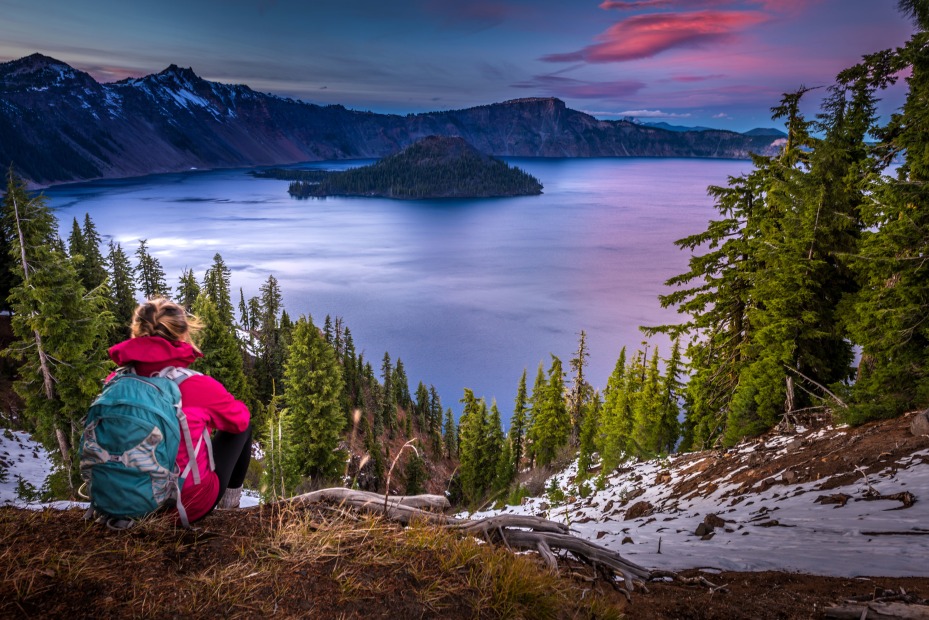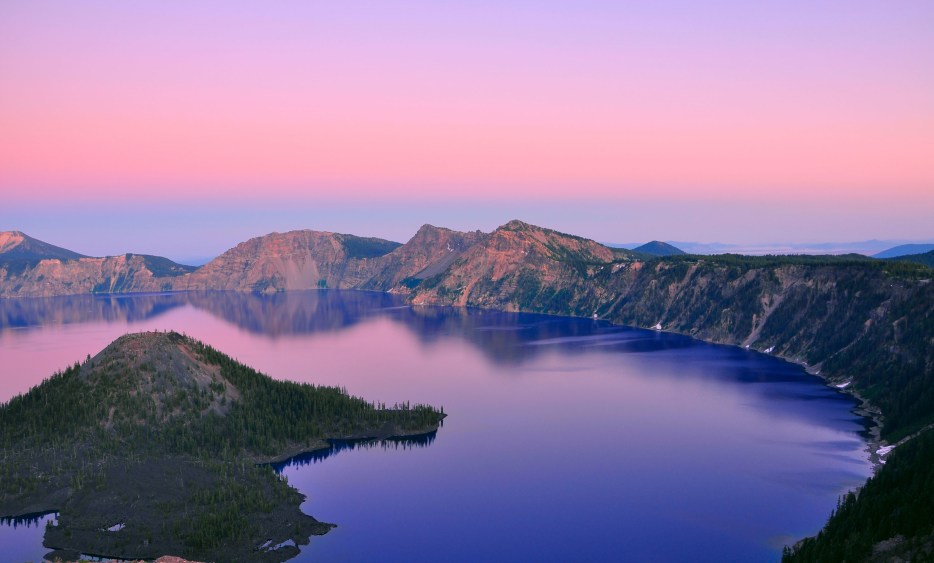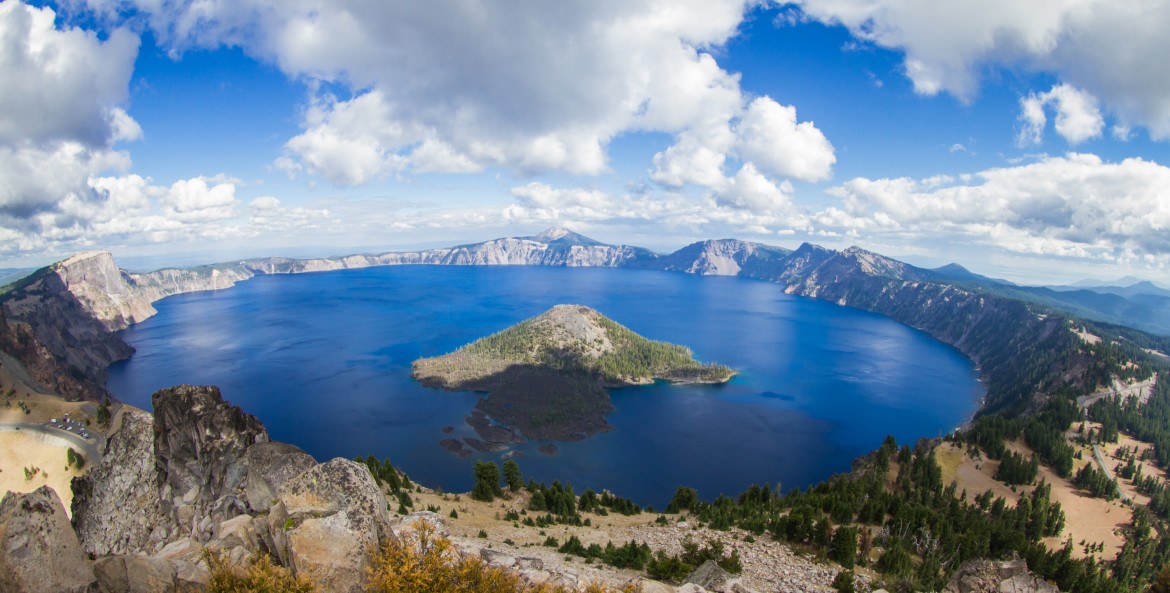Just an hour into a hike on the Garfield Peak trail at Crater Lake National Park, I heard it: a piercing eeeek! that sounded like a dog’s toy. After fumbling for my camera, I squeezed off a few snapshots in the direction of the squeal. As I’d hoped, it came from a pika, a fist-size cousin of the rabbit that rivals the koala bear in cuteness. The critter hurriedly gathered flowers and grasses like a manic florist.
Most visitors to this 183,224-acre national park in southern Oregon are so focused on marveling at the lake—and it is a marvel—that they overlook magical scenes like this one. Granted, the six-mile-wide body of water, lodged within a punch bowl–like caldera formed 7,700 years ago by a massive volcanic explosion at Mount Mazama, merits the attention travelers give it.

Keep an ear out for pika.
Wildlife in Crater Lake National Park
But the park also boasts dense woods, sheer bluffs, surreal geological formations, and remarkable creatures such as the pika. Abounding in scientific curiosities, this landscape exerts as strong a pull on researchers as it does on tourists. You can transform a trip here from mere sightseeing to true exploration by looking at the park the way scientists do. “If you aren’t cued in on a species, you can walk right by it and not even know it’s there,” says University of Idaho pika researcher Mackenzie Jeffress. “But once you pick up that call of the pika, you’ll be amazed at how much you hear it.”
Pure Blue Water of Crater Lake
The park’s star attraction—the lake—is similarly as much a scientific wonder as a sensory one. Nearly 2,000 feet from surface to bottom, Crater is the nation’s deepest lake. With no rivers running in or out, it relies on rain and snow (and some springs) to stay filled.
Sealed off from inflow and man-made pollutants that would muddy the waters, and with its naturally low concentration of nutrients such as phosphorus and nitrogen, which helps limit the growth of algae, it’s one of the clearest lakes in the world—if not the clearest.
“It’s very pure,” says Mark Buktenica, the park’s aquatic ecologist. “Because of that purity, light penetrates really deep.” And thanks to that transparency and depth, the water absorbs every color in sunlight except blue, which scatters back to the surface and accounts for the lake’s legendary hue.

Rocking chairs and overlook Crater Lake.
How clear is the water? Buktenica once piloted a research submarine to the lake’s deepest point and turned off the lights. In other waters, he’d have been plunged into blackness. Here he could see the silhouette of a dive flag mounted on the sub.
Don’t have a sub? You can experience many of the lake’s wonders on land. At the Sinnott Memorial Overlook, an interpretive center perched on the caldera’s rim, TV monitors show video footage taken during exploratory dives, revealing a strange underwater world that includes aquatic moss and peat beds 30 feet thick and 5,000 years old. “We haven’t found any other lakes with similar living or ancient communities,” Buktenica says.

Backpacker looking at Crater Lake at Sunset.
Wizard Island Sites
The lake’s Wizard Island also offers rare glimpses of the natural world. Getting there is an adventure in itself, involving a steep hike down (and later, back up) the 1.1-mile Cleetwood Trail along the caldera’s inside wall. From the dock, a tour boat offers the only transportation to the island.
Wizard Island is the only place other than the Cleetwood Trail where visitors can hike inside the rim. Along its shoreline, travelers can fish for kokanee salmon and rainbow trout—no license required. Those eager for a workout can hike to the top. A trail that encircles the summit offers a shifting perspective of the lake, the surrounding cliffs, and the island’s own mini caldera.

Beautiful view of Crater Lake.
Best Views of Crater Lake
Vistas you can reach by car are sprinkled along the 33-mile Rim Drive that rings Crater Lake. Cloudcap Overlook, for instance, at nearly 8,000 feet in elevation, awards glimpses of a stand of whitebark pines, a high-altitude species admired for its wind-twisted shapes.
Expert Led Experiences and Activities
For perhaps the closest connection to the park’s natural wonders, visitors can team up with researchers. About every other year, Crater Lake hosts a daylong BioBlitz in which groups of scientists and volunteers fan out to survey different species. “A lot of the parks haven’t been as explored as you might think in terms of what species occur there,” says John Villella, a lichenologist who participated in the park’s 2008 BioBlitz, which identified dozens of types of lichen previously undocumented at Crater Lake. “I knew we would add new species, but I didn’t realize we would almost double the number!”
In 2010, a BioBlitz that targeted amphibians confirmed an evolution-related hypothesis worthy of the Galápagos Islands. Scientists have long known that the newts living in the lake look different from newts elsewhere, with dark undersides rather than the typical orange coloration. Samples gathered during 2010’s BioBlitz indicate why: Isolated within the caldera, the so-called Mazama newts have diverged genetically from newts found in ponds elsewhere in the same park.
“Citizen scientists—K-through-12 students all the way up through retirees—were able to help us understand the diversity of amphibians,” says Andrew Ray, former science coordinator at Crater Lake Science and Learning Center. “Those results demonstrate that discovery is still occurring at Crater Lake today.”
Quick Facts About Crater Lake
- Before acquiring its current moniker in 1869, Crater Lake was known as Deep Blue Lake (1853), Blue Lake (1862), and Lake Majesty (1865).
- The water is so clear that you can see down more than 100 feet and so plentiful—4.6 trillion gallons—that it absorbs all colors except blue.
- A fallen tree nicknamed the Old Man has been observed floating around the lake, upright, for over a century.
- The lake has no native fish. Though six species were stocked between 1888 and 1941, only rainbow trout and kokanee salmon remain.
- Sonar testing in 2000 found that a geological survey of the lake’s depth conducted in 1886 was off by only 75 feet.
